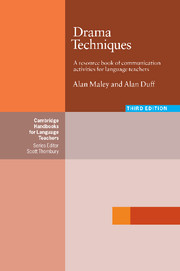Book contents
- Frontmatter
- Contents
- Thanks and acknowledgements
- Introduction
- 1 Getting ready
- 2 Observation
- 3 Working with mime
- 4 Working with the voice
- 5 Working with objects
- 6 Working with visuals
- 7 Working with the imagination
- 8 Working from/into words, phrases, sentences
- 9 Working from/into texts
- 10 Working from/into scenarios and scripts
- 11 Into Performance
- Bibliography
- Index
1 - Getting ready
Published online by Cambridge University Press: 03 May 2010
- Frontmatter
- Contents
- Thanks and acknowledgements
- Introduction
- 1 Getting ready
- 2 Observation
- 3 Working with mime
- 4 Working with the voice
- 5 Working with objects
- 6 Working with visuals
- 7 Working with the imagination
- 8 Working from/into words, phrases, sentences
- 9 Working from/into texts
- 10 Working from/into scenarios and scripts
- 11 Into Performance
- Bibliography
- Index
Summary
This chapter includes both non-verbal and verbal activities. None of them take very long to do. All of them are intended to get students in the mood for more extended drama activities. More specifically:
They all involve a degree of physical activity, thus helping to restore the balance between thinking and doing.
They help put students in a relaxed, less inhibited state, in which they are more receptive than they might otherwise be. This helps to lower the threshold of unconscious resistance to learning a foreign language, and to foster more open, creative work in subsequent activities.
They help to develop confidence and cooperation with others. Being aware of others and how we relate to them is an important aspect of class bonding.
They can help students to make a smooth transition from their activities outside the class (perhaps a lesson in a different subject, or the stress of coming from a job in heavy traffic) to the learning atmosphere of the language class.
They may also be used to make smooth links between one activity and the next.
There are four main types of activity:
1 non-verbal warming up
2 non-verbal relaxation / cooling down
3 activities involving language
4 group formation activities.
The way you choose to use the activities is up to you. As you come to get the feel of your class group, you will know best which ones to use at which moments. There is no grading, though activities are presented in clusters when they share common elements.
- Type
- Chapter
- Information
- Drama TechniquesA Resource Book of Communication Activities for Language Teachers, pp. 6 - 37Publisher: Cambridge University PressPrint publication year: 2005



